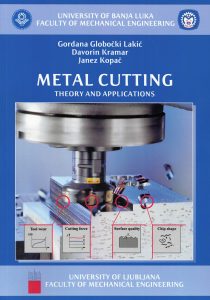
Gordana Globočki Lakić, Davorin Kramar, Janez Kopač
2014
XIII, 221 str.
ISBN 978-961-6536-85-1
Enotna cena: 21,00 €
Preface
Dear readers,
More than 5% of the world GDP is related to machining processes as part of manufacturing technologies. This proves that knowledge about machining processes is strategically important and has to be further improved. With this in mind, the idea is to have a book that gives us an opportunity to open it at any time and provide us with theoretical or/and technological information about machining processes. Therefore, this book covers the most important processes, such as turning, milling, dril1ing, etc. Besides conventional, this book also describes cutting-edge technologies. The basic cutting theory is similar or practically the same for all the processes, while for further development, we must be familiar with the mechanisms occurring in the cutting zone and improve this understanding. In the cutting zone takes place the transformation of material, where material is separated from the workpiece,
producing chips, and what is most valuable – the final shaped workpiece (product).
However, technicians and engineers must also become familiar, besides conventional, with the latest sound developments in this field, and make a step further in the real production environment. Therefore, we still have to improve our knowledge and fully comprehend cutting processes and focus on mechanisms and reasons for successful or less successful cutting. This can be achieved through a careful and precise analysis of the cutting process behaviour. Machining problems such as bad surface roughness, unpredictable tool-wear and vibration occurrence (chatter), are directly related to the machining parameters. Usual1y, when these problems occur, they have to be minimised. This will however lead to lower productivity, while trends require the opposite. The solution lies in careful analyses and the development of predictive performance models that can predict the process behaviour as well as the mentioned problems. The fact is that in order to prevent bad machining scenarios, one must predict them. These are the reasons why further analysis, research, and studies of the cutting theory, processes and technologies, are inevitable. Ideally, improved knowledge would offer the possibility of finding the best/optimal solution for any specific/unique problem. Nevertheless, this cannot be done without the strong support of a theoretical background.
What is the difference between a technician and an engineer? The technician is an operator responsible for the realization of the machining production (by using modern machine tools, of course). On the other side, the engineer is a person who has to take care of the preparation of technology and definition of optimal cutting/machining parameters. And the fact is that there can be no single optimal solution in machining. This depends on specific objectives that we have, and they are case-based. In general, these objectives pertain to three main areas: cost optimization, time optimization and quality optimization. All the objectives are in fact opposite in nature. It is therefore important for process planning to consider all the conditions and choose the right viewpoint for optimization. Moreover, recent trends are directed towards a sustainable production, sustainable machining, etc. In order to reach the goal of this idea, the
book is encouraging engineers to act in a manner where they can significantly contribute to saving energy, reducing consumption of cooling/lubrication f1uids, minimizing waste, etc.
Authors